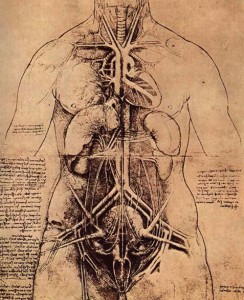I’ve been thinking a lot about imaginary body parts recently. The Queen’s Gallery is opening a new exhibition of the anatomical drawings of Leonardo da Vinci in May; put it on your ‘to do’ list if you are in London — http://www.royalcollection.org.uk/exhibitions/leonardo-da-vinci-anatomist – and I have done some work for the audio guide and the app (which means you can ‘see’ it even if you are not in London!). One of the amazing things about these pages from Leonardo’s notebooks is that many (to the non-anatomist) very convincing pictures were drawn from his imagination, before he had access to human body parts to dissect. In particular, a sketch of coitus shows him thinking about where everything goes – and includes imaginary channels from the womb to the breasts, based on the ancient belief that breast milk is made out of menstrual blood. His sketch of the penis has an extra channel for the soul to be transmitted through. His section of the female body includes parts from animals. His famous drawing of the foetus in the womb is based on a real foetus, but when he did it he had not seen the womb, so that was idealised as a sphere, and the drawings surrounding it are based on the placenta of a cow. And so on.
Leonardo’s drawings show us the early stages of what happened when the ideas about the body inherited from Greek and Roman medicine were challenged by the ‘real’ body. A later example is the work of William Harvey. Before Harvey, it was thought that blood made its way from one side of the heart to the other through ‘invisible holes’ in the septum that divides right from left. One of the preconditions for Harvey’s 1628 announcement of the circulation of the blood was the discovery of the pulmonary transit, the movement of blood from one side of the heart, to the lungs, and back again to the other side of the heart. But the pulmonary transit had been proposed much earlier, for example by Ibn al-Nafīs in the thirteenth century. Harvey’s work was based on a combination of speculation, based on his observations about the sheer quantity of blood in the body, and animal vivisection; that of Ibn al-Nafīs was pure speculation, based on the requirements of his thinking about the body in theological and philosophical terms. Harvey rejected the imaginary ‘invisible holes’, but for his theory of circulation to work he had to rely on something else that was invisible – the capillaries, which his theory of circulation needed as the route between the arterial system and the venous system. Harvey couldn’t see them, as microscopy was not quite sufficiently developed.
But while ‘invisible holes’ in the septum of the heart are Wrong, ‘invisible channels’ between arteries and veins are Right. So far!

